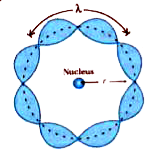Explain the quantization of angular momentum to behave an electron as wave in a atom.Solution in Gujrati
To introduce the atomic model Bohr in his second hypothesis said that the angular momentum of the electron orbiting around the nucleus is quantised.
Louis de Broglie explain this in 1923.
According to de Broglie.s hypothesis material particles have a wave nature. Davisson and Germer experimentally verified the wave nature.
Bohr proposed that the electron in a circular orbit should be as matter wave.
The waves travelling on a string, particle waves too can lead to standing waves under resonant condition.
When a string is plucked, a vast number of waves (wavelengths) are excited only those waves survive which have nodes at the ends and form the standing waves in the string. It means that in a string, standing waves are formed when the total distance travelled by a wave down the string and back is one wavelength, two wavelengths or any integral number of wavelength.
Waves with other wavelength interfere with themselves upon reflection and their amplitudes quickly drop to zero. Under this position the electron cannot remain in such orbit.
For an electron moving in nth circular orbit of radius rn the total distance is the circumference of the orbit.
∴ Circumference of orbit = n wavelength
∴2πrn=nλ...(1)wheren=1,2,3,...

Figure shows the standing wave located at the circular orbit for the four wavelength.
Here n = 4
The relation of de Broglie wavelength and momentum
λ=hp=hmvn....2[∴p=mvn]
From equation (1) and (2),
2πrn=n(hmvn) ∴mvnrn=nh2π
which is the second hypothesis of Bohr atomic model. Momentum is always multiple integer of h2π. Hence, de Broglie explained the 211 quantization of the angular momentum of the orbiting electrons. The quantised electron orbits and energy states are due to the wave nature of the electron and only resonant standing waves can persist.
Topper's Solved these Questions
- BOOK - KUMAR PRAKASHANCHAPTER - ATOMSEXERCISE - TRY YOURSELF43videos
ATOMS
- BOOK - KUMAR PRAKASHANCHAPTER - ATOMSEXERCISE - SECTION-B (NUMERICALS) (Numerical From Textual Illustrations)9videos
ATOMS
- BOOK - KUMAR PRAKASHANCHAPTER - ALTERNATING CURRENTS EXERCISE - SECTION-D MCQs (COMPETITIVE EXAMS)64videos
ALTERNATING CURRENTS
- BOOK - KUMAR PRAKASHANCHAPTER - BOARD'S QUESTION PAPER MARCH-2020 EXERCISE - PART-B SECTION -C4videos
BOARD'S QUESTION PAPER MARCH-2020
Similar Questions
Why atoms are electrical neutral ?
01:40View SolutionIn the Rutherford’s nuclear model of the atom, the nucleus (radius about 10–15 m) is analogous to the sun about which the electron move in orbit (radius ≈10–10 m) like the earth orbits around the sun. If the dimensions of the solar system had the same proportions as those of the atom, would the earth be closer to or farther away from the sun than actually it is? The radius of earth’s orbit is about 1.5×1011m. The radius of sun is taken as 7×108m.
02:06View SolutionPower factor of AC series circuit having resistance R and inductor L having angular frequency ω is ……..
01:31View SolutionDerive an expression for current I passing through an AC circuit containing only inductor L. Draw a Phasor diagram and graph of v and I versus ωt. Explain instantaneous power and the average power.
03:02View SolutionIs the angular momentum of an electron in an atom quantized ? Explain
02:47View SolutionThe angular momentum of an electron in an orbit is quantized because irt is a necessary condition for the compatibility with
02:25View SolutionThe angular momentum of an electron in an orbit is quantized because:
02:08View SolutionThe angular momentum of an electron in an orbit is quantized because it is a necessary condition for the compatibility with:
05:45View SolutionAn electron revolves around a proton in a hydrogen atom in an orbit of radius r. Considering the wave nature of electron and assuming that electron is present in the form of a stationary wave. Show that the angular momentum of the electron is quantized.
02:30View Solutionकिसी परमाणु की कक्षा में कोणीय संवेग के क्वांटिकरण का निर्गमन किसने दिया ।
02:39View Solutionद्रव्य-तरंग अभिधारणा बोर के कोणीय संवेग क्वांटीकरण की व्याख्या करें।
04:32View Solutionकिसी परमाणु में इलेक्ट्रॉनों का कोणीय संवेग क्वांटीकृत होता है ।
View Solutionद्वितीय कक्षा में इलेक्ट्रॉन के कोणीय संवेग के लिए क्वांटीकरण प्रतिबंध लिखिए |
05:10View Solutionद्वितीय कक्षा में इलेक्ट्रॉन के कोणीय संवेग के लिए क्वांटीकरण प्रतिबंध लिखिए।
02:11View SolutionA: Angular momentum of an electron in an atom is quantized R : in an atom only orbitals are permitted in which angular momentum of the electron is a natural number multiple of (h)/( 2 pi)
01:48View Solution

